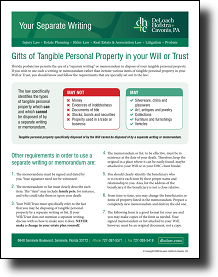
Florida probate law permits the use of a “separate writing” or memorandum to dispose of your tangible personal property.
If you wish to use such writing or memorandum rather than itemize various items of tangible personal property in your Will (or Trust), you should know and follow the requirements that are specially set out in the law:
The law specifically identifies the types of tangible personal property which can and which cannot be disposed of by a separate writing or memorandum.
Tangible Personal Property Which May Not Be Disposed of by Separate Writing or Memorandum Includes:
- money
- evidences of indebtedness (i.e., promissory notes)
- documents of title
- stocks, bonds and securities
- property used in a trade or business
- and other tangible personal property specifically disposed of by Will.
All Other Types of Tangible Personal Property May Be Disposed of by Separate Writing or Memorandum, Such as:
- art, antiques, and jewelry
- silverware, china and glassware
- collections (stamps, baseball cards, comic books, etc.)
- furniture and furnishings
- vehicles
- and other items of tangible personal property
Other requirements in order to use a separate writing or memorandum are:
-
The memorandum must be signed and dated by you. Your signature need not be witnessed.
-
The memorandum or list must clearly describe each item. The “item” may include family pets, for instance, and who could take them in upon your death.
-
Your Will (or Trust) must specifically refer to the fact that you may be disposing of tangible personal property by a separate writing or list. If your Will or Trust does not mention a separate writing, discuss with us how to make sure it does. NEVER make a change in the Will (or Trust) yourself.
-
The memorandum or list, to be effective, must be in existence at the date of your death. Therefore, keep it in a place where it can be easily found, maybe attached to your Will or in the binder we provided you (if you were our client).
-
You should clearly identify the beneficiary who is to receive each item by their proper name and relationship to you. Also, list the address of the beneficiary if the beneficiary is not a close relative.
-
From time to time, you may change the beneficiaries or items of property listed in the memorandum. Prepare a completely new memorandum and destroy the old one.
-
This form is a good format for your use. Make additional copies as needed.

